J
James Brodie
Guest
Peugeot has confirmed pricing and specifications for its third-generation 308, with the new family hatchback to start from £24,000.
The 308 is the first car to feature the brand’s new logo as part of its recent rebrand to push Peugeot upmarket. However, the new 308 - available as a plug-in hybrid for the first time - will retain its relatively affordable price tag at the lower end of the range.
However, given the technology involved in plug-in models, prices will rise from the entry-level car’s £24,000 to £38,800 for the range-topping hybrid.
The 308 uses the same platform as its predecessor, but the latest version of the EMP2 architecture - developed by the PSA division of the Stellantis group - has seen heavy development since its introduction in 2013, when the second-generation 308 was the first Peugeot model to use it.
The introduction of electrification isn’t the only big change for this new model. The new 308 features an interior overhaul to support the brand’s push upmarket, while there have also been steps forward when it comes to infotainment and driver assistance technology.
Peugeot has recently introduced an evolution of its latest design language on the facelifted 3008 SUV, and though the 308 is smaller and sportier, it’s still in keeping with its higher riding and more practical sibling.
The bonnet swoops downwards to create a lower looking nose than before, while beneath it sits a new, larger grille wearing that updated badge. Slimmer headlights are integrated into the edges of the grille, alongside Peugeot’s fang-like LED daytime running lights.
A strong shoulder line runs from the top of the headlight to the tail light, and there are two prominent new creases above the front and rear wheels.
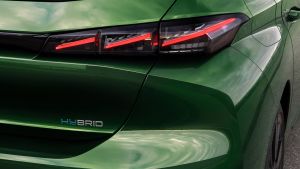
Peugeot 308 - rear lights
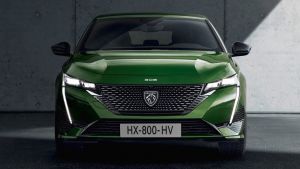
Peugeot 308 - full front static
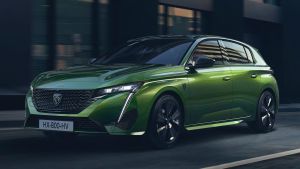
Peugeot 308 - front static

Peugeot 308 - front static
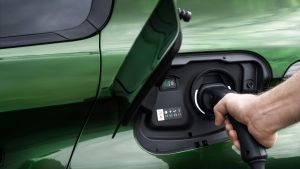
Peugeot 308 - charging
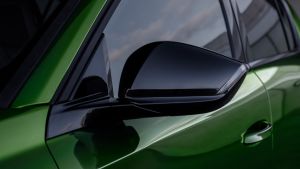
Peugeot 308 - wing mirror
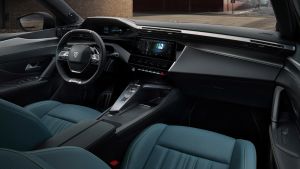
Peugeot 308 - cabin
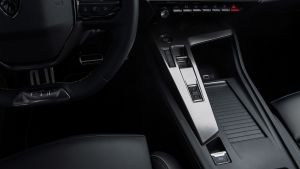
Peugeot 308 - centre console
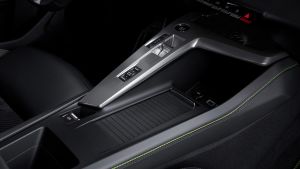
Peugeot 308 - wireless charging
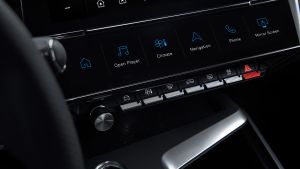
Peugeot 308 - interior

Peugeot 308 - front
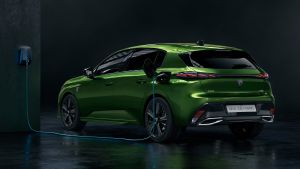
Peugeot 308 - studio rear charging
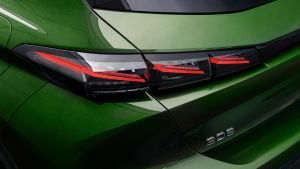
Peugeot 308 - rear detail
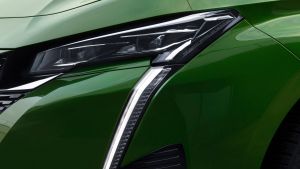
Peugeot 308 - front lights
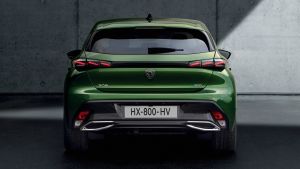
Peugeot 308 - full rear static
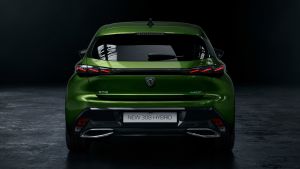
Peugeot 308 - studio full rear
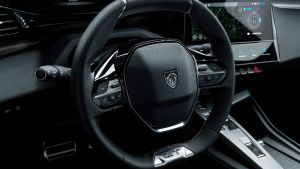
Peugeot 308 - steering wheel
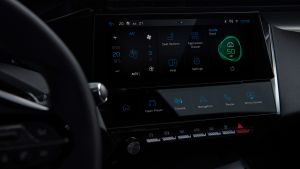
Peugeot 308 - screen
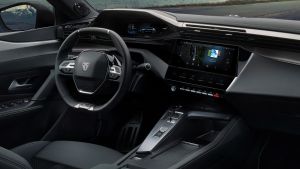
Peugeot 308 - dash
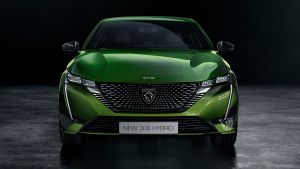
Peugeot 308 - studio full front
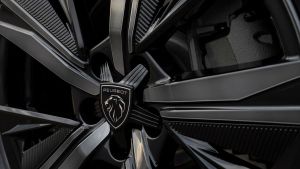
Peugeot 308 - wheel
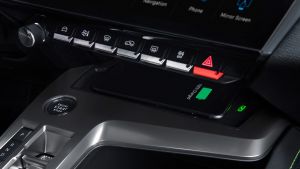
Peugeot 308 - interior buttons

Peugeot 308 - rear

Peugeot 308 - studio rear
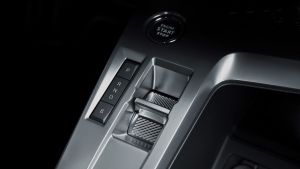
Peugeot 308 - transmission
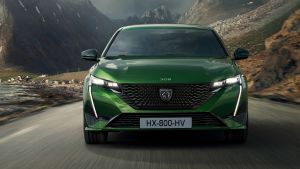
Peugeot 308 - full front

Peugeot 308 - studio front charging
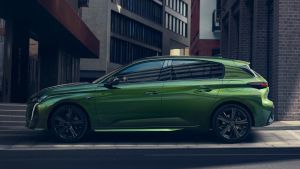
Peugeot 308 - side

Peugeot 308 - studio front
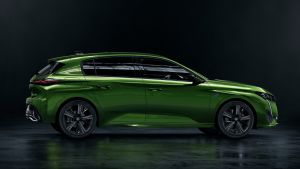
Peugeot 308 - studio side
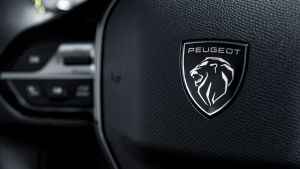
Peugeot 308 - steering wheel detail

Peugeot 308 - infotainment
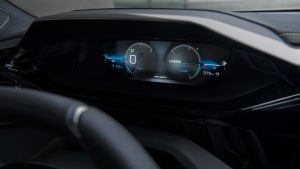
Peugeot 308 - dials

Peugeot 308 - front grille

Peugeot 308 - rear badge
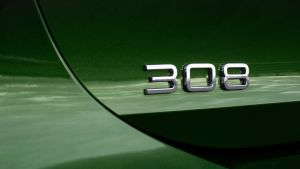
Peugeot 308 - 308 badge
At the back, there’s a prominent rear spoiler on the boot door, while the tailgate is headlined by another typical modern Peugeot design feature - tail lights with three ‘claw’ style lighting elements.
It’s 11mm longer than the old car, at 4,360mm, and 20mm lower. But more importantly, the wheelbase has grown by 55mm, so despite the more rakish looking rear end, space in the back has improved.
Boot space stands at 412 litres, so the new 308 should prove one of the more practical options in the family hatchback category when it goes on sale. It means the boot is larger than the Volkswagen Golf, Hyundai i30, Ford Focus or Mercedes A-Class.
A more practical estate ‘SW’ version will go on sale soon.
Inside, the 308 has undergone a heavy transformation. The dashboard integrates some of Peugeot’s newest infotainment and display technology into a completely new design, to place some distance between the 308 and the 3008 SUV.
The tall, sloping dashboard features air vents placed high up, while a sharp-looking 10-inch touchscreen display on the dashboard controls most of the in-car tech, and now features wireless Android Auto and Apple CarPlay compatibility.
There are two versions of this screen - the basic i-Connect version and the i-Connect plus, which features widescreen navigation from TomTom. The new graphical interface is customisable and uses a widget-based organisation system, like a smartphone or tablet.
Beneath it is a row of freely configurable touch-sensitive controls, called ‘i-Toggles’. Each one is a shortcut to a major function, such as climate control, the telephone or radio. A row of ‘piano key’ style buttons sits at the base of the infotainment zone.

Peugeot 308 - rear lights

Peugeot 308 - full front static

Peugeot 308 - front static

Peugeot 308 - front static

Peugeot 308 - charging

Peugeot 308 - wing mirror

Peugeot 308 - cabin

Peugeot 308 - centre console

Peugeot 308 - wireless charging

Peugeot 308 - interior

Peugeot 308 - front

Peugeot 308 - studio rear charging

Peugeot 308 - rear detail

Peugeot 308 - front lights

Peugeot 308 - full rear static

Peugeot 308 - studio full rear

Peugeot 308 - steering wheel

Peugeot 308 - screen

Peugeot 308 - dash

Peugeot 308 - studio full front

Peugeot 308 - wheel

Peugeot 308 - interior buttons

Peugeot 308 - rear

Peugeot 308 - studio rear

Peugeot 308 - transmission

Peugeot 308 - full front

Peugeot 308 - studio front charging

Peugeot 308 - side

Peugeot 308 - studio front

Peugeot 308 - studio side

Peugeot 308 - steering wheel detail

Peugeot 308 - infotainment

Peugeot 308 - dials

Peugeot 308 - front grille

Peugeot 308 - rear badge

Peugeot 308 - 308 badge
The 308 continues to use Peugeot’s i-Cockpit steering wheel and instrument layout. That means that the small steering wheel sits below the new digital instrument panel, which is now available with the clever 3D image tech used on the brand’s smaller 208 supermini.
The large centre console gets a new look too. It comes with 34 litres of storage space, including a large cubby, which is home to a wireless smartphone charger.
Luxury touches include the availability of nappa leather upholstery and massaging seats. There’s also a new cabin air filtration system designed to keep polluting gasses and particles out, with the cabin air quality level displayed on the infotainment screen.
Peugeot will offer the 308 with one pure petrol option, one diesel, and two petrol plug-in hybrids. All are exclusively available with an 8-speed automatic gearbox.
The petrol engine, the PureTech 130, is a 1.2-litre turbocharged three-cylinder developing 128bhp. The sole diesel unit is Peugeot’s BlueHDi 130, a turbocharged 1.5-litre four-cylinder engine also developing 128bhp.
The two-strong plug-in hybrid line-up opens with the Hybrid 180 model, which available for all but the lowest Active Premium trim level. This combines a 148bhp PureTech petrol engine with a 109bhp electric motor and a 12.4kWh battery. That’s a smaller battery to the 3008 plug-in hybrid, but Peugeot claims that 37 miles of pure electric running is possible in the 308, alongside CO2 emissions as low as 25g/km, which should make it a compelling company car choice.

Peugeot 308 - rear lights

Peugeot 308 - full front static

Peugeot 308 - front static

Peugeot 308 - front static

Peugeot 308 - charging

Peugeot 308 - wing mirror

Peugeot 308 - cabin

Peugeot 308 - centre console

Peugeot 308 - wireless charging

Peugeot 308 - interior

Peugeot 308 - front

Peugeot 308 - studio rear charging

Peugeot 308 - rear detail

Peugeot 308 - front lights

Peugeot 308 - full rear static

Peugeot 308 - studio full rear

Peugeot 308 - steering wheel

Peugeot 308 - screen

Peugeot 308 - dash

Peugeot 308 - studio full front

Peugeot 308 - wheel

Peugeot 308 - interior buttons

Peugeot 308 - rear

Peugeot 308 - studio rear

Peugeot 308 - transmission

Peugeot 308 - full front

Peugeot 308 - studio front charging

Peugeot 308 - side

Peugeot 308 - studio front

Peugeot 308 - studio side

Peugeot 308 - steering wheel detail

Peugeot 308 - infotainment

Peugeot 308 - dials

Peugeot 308 - front grille

Peugeot 308 - rear badge

Peugeot 308 - 308 badge
More power can be had with the Hybrid 225 drivetrain, available with the top two trim levels - GT and GT Premium. This combines a 178bhp petrol engine with the same 109bhp electric motor for a maximum combined power output of 222bhp. Again, up to 37 miles of battery running is claimed, while CO2 is up marginally to 26g/km.
From a household plug, both batteries will be replenished in just over seven hours; 3.7kW single-phase charging is supported as standard, which means recharges will take three hours and 50 minutes. A 7.4kW on-board charger will be available as an option, and plugged into a wallbox the battery will take one hour and 50 minutes to be topped up.
The plug-in hybrid versions of the 308 feature a thermal pre-conditioning function too. Via the MyPeugeot smartphone app or the car’s touchscreen, users can schedule a wake-up point for the battery. This means that the cells can be at the optimal temperature for efficiency from start-up, while the cabin can be pre-heated or cooled as well.
Peugeot Drive Assist 2.0 is making its debut on the new 308 - the latest development of the firm’s semi-autonomous driver assistance technology.
Whereas before, Drive Assist relied on stop-and-go cruise control and lane-keep assist, the new version can now automatically adapt the speed of the car around curves, operating at speeds up to 112mph.
Elsewhere, the new 308 gains a long-range blind-spot-monitoring function, rear cross traffic alert and a reversing camera with a 180-degree field of view. A 360-degree top-down style camera is also available.
Adaptive cruise with a full stop-and-go function is also available with the new 308. Automatic high-beam and traffic sign recognition are offered too, while every version gets an electronic parking brake.
The new 308 will be available in five trim levels - Active Premium, Allure and Allure Premium, with sporty GT and GT Premium versions topping out the range.
Active Premium cars come fitted with 16-inch alloy wheels, EcoLED automatic headlights and LED tail lights. Even this model gets the 10-inch infotainment display with Android Auto and Apple CarPlay, as well as rear parking sensors. Prices start at £24,000.
For £1,850 more, Allure spec adds bigger, 17-inch alloys, leather effect interior trim and ambient lighting. Also included is Peugeot’s Connected 3D navigation system, along with its i-Connect voice assistant, a reversing camera and front parking sensors.
Allure Premium models are priced from £26,750, with Drive Assist 2.0 added to the mix. Also included is wireless phone charging and wireless CarPlay and Android Auto.
GT trim brings a range of exterior upgrades, such as 18-inch alloys, Matrix LED headlights, a dark chrome front grille and extended side sills. Inside, you get a 3D instrument cluster, a heated steering wheel and Alcantara trim on the seats. GT trim cars start from £28,650.
The range topping 308 GT Premium can be had for £30,250, and features a Focal Premium HiFi and upgraded seats, with a massage function and electric lumbar support. Peugeot's Drive Assist Pack Plus is also fitted, with semi-autonomous lane keep assist. GT Premium also brings a 360-degree camera and semi-autonomous park assist.
The new 308 is available now, with first UK deliveries expected in December this year.
What are the best plug-in hybrids on sale right now? Click here for our top 10...
Continue reading...
The 308 is the first car to feature the brand’s new logo as part of its recent rebrand to push Peugeot upmarket. However, the new 308 - available as a plug-in hybrid for the first time - will retain its relatively affordable price tag at the lower end of the range.
- SEE MORE Best hatchbacks to buy 2021
However, given the technology involved in plug-in models, prices will rise from the entry-level car’s £24,000 to £38,800 for the range-topping hybrid.
The 308 uses the same platform as its predecessor, but the latest version of the EMP2 architecture - developed by the PSA division of the Stellantis group - has seen heavy development since its introduction in 2013, when the second-generation 308 was the first Peugeot model to use it.
The introduction of electrification isn’t the only big change for this new model. The new 308 features an interior overhaul to support the brand’s push upmarket, while there have also been steps forward when it comes to infotainment and driver assistance technology.
New 2021 Peugeot 308: design and practicality
Peugeot has recently introduced an evolution of its latest design language on the facelifted 3008 SUV, and though the 308 is smaller and sportier, it’s still in keeping with its higher riding and more practical sibling.
The bonnet swoops downwards to create a lower looking nose than before, while beneath it sits a new, larger grille wearing that updated badge. Slimmer headlights are integrated into the edges of the grille, alongside Peugeot’s fang-like LED daytime running lights.
A strong shoulder line runs from the top of the headlight to the tail light, and there are two prominent new creases above the front and rear wheels.

Peugeot 308 - rear lights

Peugeot 308 - full front static

Peugeot 308 - front static

Peugeot 308 - front static

Peugeot 308 - charging

Peugeot 308 - wing mirror

Peugeot 308 - cabin

Peugeot 308 - centre console

Peugeot 308 - wireless charging

Peugeot 308 - interior

Peugeot 308 - front

Peugeot 308 - studio rear charging

Peugeot 308 - rear detail

Peugeot 308 - front lights

Peugeot 308 - full rear static

Peugeot 308 - studio full rear

Peugeot 308 - steering wheel

Peugeot 308 - screen

Peugeot 308 - dash

Peugeot 308 - studio full front

Peugeot 308 - wheel

Peugeot 308 - interior buttons

Peugeot 308 - rear

Peugeot 308 - studio rear

Peugeot 308 - transmission

Peugeot 308 - full front

Peugeot 308 - studio front charging

Peugeot 308 - side

Peugeot 308 - studio front

Peugeot 308 - studio side

Peugeot 308 - steering wheel detail

Peugeot 308 - infotainment

Peugeot 308 - dials

Peugeot 308 - front grille

Peugeot 308 - rear badge

Peugeot 308 - 308 badge
At the back, there’s a prominent rear spoiler on the boot door, while the tailgate is headlined by another typical modern Peugeot design feature - tail lights with three ‘claw’ style lighting elements.
It’s 11mm longer than the old car, at 4,360mm, and 20mm lower. But more importantly, the wheelbase has grown by 55mm, so despite the more rakish looking rear end, space in the back has improved.
Boot space stands at 412 litres, so the new 308 should prove one of the more practical options in the family hatchback category when it goes on sale. It means the boot is larger than the Volkswagen Golf, Hyundai i30, Ford Focus or Mercedes A-Class.
A more practical estate ‘SW’ version will go on sale soon.
New 2021 Peugeot 308: interior and technology
Inside, the 308 has undergone a heavy transformation. The dashboard integrates some of Peugeot’s newest infotainment and display technology into a completely new design, to place some distance between the 308 and the 3008 SUV.
The tall, sloping dashboard features air vents placed high up, while a sharp-looking 10-inch touchscreen display on the dashboard controls most of the in-car tech, and now features wireless Android Auto and Apple CarPlay compatibility.
There are two versions of this screen - the basic i-Connect version and the i-Connect plus, which features widescreen navigation from TomTom. The new graphical interface is customisable and uses a widget-based organisation system, like a smartphone or tablet.
Beneath it is a row of freely configurable touch-sensitive controls, called ‘i-Toggles’. Each one is a shortcut to a major function, such as climate control, the telephone or radio. A row of ‘piano key’ style buttons sits at the base of the infotainment zone.

Peugeot 308 - rear lights

Peugeot 308 - full front static

Peugeot 308 - front static

Peugeot 308 - front static

Peugeot 308 - charging

Peugeot 308 - wing mirror

Peugeot 308 - cabin

Peugeot 308 - centre console

Peugeot 308 - wireless charging

Peugeot 308 - interior

Peugeot 308 - front

Peugeot 308 - studio rear charging

Peugeot 308 - rear detail

Peugeot 308 - front lights

Peugeot 308 - full rear static

Peugeot 308 - studio full rear

Peugeot 308 - steering wheel

Peugeot 308 - screen

Peugeot 308 - dash

Peugeot 308 - studio full front

Peugeot 308 - wheel

Peugeot 308 - interior buttons

Peugeot 308 - rear

Peugeot 308 - studio rear

Peugeot 308 - transmission

Peugeot 308 - full front

Peugeot 308 - studio front charging

Peugeot 308 - side

Peugeot 308 - studio front

Peugeot 308 - studio side

Peugeot 308 - steering wheel detail

Peugeot 308 - infotainment

Peugeot 308 - dials

Peugeot 308 - front grille

Peugeot 308 - rear badge

Peugeot 308 - 308 badge
The 308 continues to use Peugeot’s i-Cockpit steering wheel and instrument layout. That means that the small steering wheel sits below the new digital instrument panel, which is now available with the clever 3D image tech used on the brand’s smaller 208 supermini.
The large centre console gets a new look too. It comes with 34 litres of storage space, including a large cubby, which is home to a wireless smartphone charger.
Luxury touches include the availability of nappa leather upholstery and massaging seats. There’s also a new cabin air filtration system designed to keep polluting gasses and particles out, with the cabin air quality level displayed on the infotainment screen.
New 2021 Peugeot 308: engines and hybrid drivetrains
Peugeot will offer the 308 with one pure petrol option, one diesel, and two petrol plug-in hybrids. All are exclusively available with an 8-speed automatic gearbox.
The petrol engine, the PureTech 130, is a 1.2-litre turbocharged three-cylinder developing 128bhp. The sole diesel unit is Peugeot’s BlueHDi 130, a turbocharged 1.5-litre four-cylinder engine also developing 128bhp.
The two-strong plug-in hybrid line-up opens with the Hybrid 180 model, which available for all but the lowest Active Premium trim level. This combines a 148bhp PureTech petrol engine with a 109bhp electric motor and a 12.4kWh battery. That’s a smaller battery to the 3008 plug-in hybrid, but Peugeot claims that 37 miles of pure electric running is possible in the 308, alongside CO2 emissions as low as 25g/km, which should make it a compelling company car choice.

Peugeot 308 - rear lights

Peugeot 308 - full front static

Peugeot 308 - front static

Peugeot 308 - front static

Peugeot 308 - charging

Peugeot 308 - wing mirror

Peugeot 308 - cabin

Peugeot 308 - centre console

Peugeot 308 - wireless charging

Peugeot 308 - interior

Peugeot 308 - front

Peugeot 308 - studio rear charging

Peugeot 308 - rear detail

Peugeot 308 - front lights

Peugeot 308 - full rear static

Peugeot 308 - studio full rear

Peugeot 308 - steering wheel

Peugeot 308 - screen

Peugeot 308 - dash

Peugeot 308 - studio full front

Peugeot 308 - wheel

Peugeot 308 - interior buttons

Peugeot 308 - rear

Peugeot 308 - studio rear

Peugeot 308 - transmission

Peugeot 308 - full front

Peugeot 308 - studio front charging

Peugeot 308 - side

Peugeot 308 - studio front

Peugeot 308 - studio side

Peugeot 308 - steering wheel detail

Peugeot 308 - infotainment

Peugeot 308 - dials

Peugeot 308 - front grille

Peugeot 308 - rear badge

Peugeot 308 - 308 badge
More power can be had with the Hybrid 225 drivetrain, available with the top two trim levels - GT and GT Premium. This combines a 178bhp petrol engine with the same 109bhp electric motor for a maximum combined power output of 222bhp. Again, up to 37 miles of battery running is claimed, while CO2 is up marginally to 26g/km.
From a household plug, both batteries will be replenished in just over seven hours; 3.7kW single-phase charging is supported as standard, which means recharges will take three hours and 50 minutes. A 7.4kW on-board charger will be available as an option, and plugged into a wallbox the battery will take one hour and 50 minutes to be topped up.
The plug-in hybrid versions of the 308 feature a thermal pre-conditioning function too. Via the MyPeugeot smartphone app or the car’s touchscreen, users can schedule a wake-up point for the battery. This means that the cells can be at the optimal temperature for efficiency from start-up, while the cabin can be pre-heated or cooled as well.
New 2021 Peugeot 308: driver assistance and safety technology
Peugeot Drive Assist 2.0 is making its debut on the new 308 - the latest development of the firm’s semi-autonomous driver assistance technology.
Whereas before, Drive Assist relied on stop-and-go cruise control and lane-keep assist, the new version can now automatically adapt the speed of the car around curves, operating at speeds up to 112mph.
Elsewhere, the new 308 gains a long-range blind-spot-monitoring function, rear cross traffic alert and a reversing camera with a 180-degree field of view. A 360-degree top-down style camera is also available.
Adaptive cruise with a full stop-and-go function is also available with the new 308. Automatic high-beam and traffic sign recognition are offered too, while every version gets an electronic parking brake.
New 2021 Peugeot 308: pricing and specs
The new 308 will be available in five trim levels - Active Premium, Allure and Allure Premium, with sporty GT and GT Premium versions topping out the range.
Active Premium cars come fitted with 16-inch alloy wheels, EcoLED automatic headlights and LED tail lights. Even this model gets the 10-inch infotainment display with Android Auto and Apple CarPlay, as well as rear parking sensors. Prices start at £24,000.
For £1,850 more, Allure spec adds bigger, 17-inch alloys, leather effect interior trim and ambient lighting. Also included is Peugeot’s Connected 3D navigation system, along with its i-Connect voice assistant, a reversing camera and front parking sensors.
Allure Premium models are priced from £26,750, with Drive Assist 2.0 added to the mix. Also included is wireless phone charging and wireless CarPlay and Android Auto.
GT trim brings a range of exterior upgrades, such as 18-inch alloys, Matrix LED headlights, a dark chrome front grille and extended side sills. Inside, you get a 3D instrument cluster, a heated steering wheel and Alcantara trim on the seats. GT trim cars start from £28,650.
The range topping 308 GT Premium can be had for £30,250, and features a Focal Premium HiFi and upgraded seats, with a massage function and electric lumbar support. Peugeot's Drive Assist Pack Plus is also fitted, with semi-autonomous lane keep assist. GT Premium also brings a 360-degree camera and semi-autonomous park assist.
The new 308 is available now, with first UK deliveries expected in December this year.
What are the best plug-in hybrids on sale right now? Click here for our top 10...
Continue reading...
